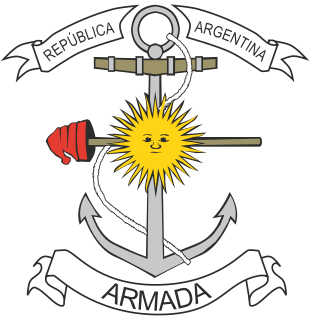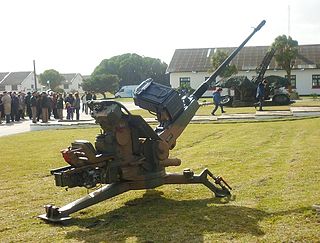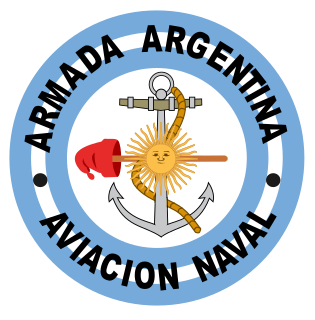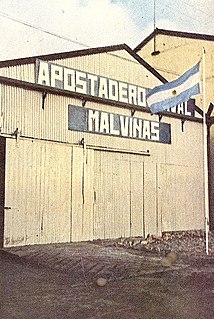Related Research Articles

This article describes the composition and actions of the Argentine air forces in the Falklands War, which comprised units of the Air Force, Army, Navy and other services.

The Argentine Navy is the navy of Argentina. It is one of the three branches of the Armed Forces of the Argentine Republic, together with the Army and the Air Force.

The Battle of Goose Green was fought May 28–29, 1982, by British and Argentine forces during the Falklands War. Located on East Falkland's central isthmus, the settlement of Goose Green was the site of an airfield. Argentine forces were in a well-defended position, within striking distance of San Carlos Water, where the British task force had made its amphibious landing.

The Argentine Air Force is the national aviation branch of the Armed Forces of the Argentine Republic. In 2018, it had 13,837 military and 6,900 civilian personnel.

The Mexican Air Force is the primary aerial warfare service branch of the Mexican Armed Forces. It is a component of the Mexican Army and depends on the National Defense Secretariat (SEDENA). The objective of the FAM is to defend the integrity, independence, and sovereignty of Mexico. Its auxiliary tasks include internal security, assisting with public works, and natural disaster management. Since December 2017, its commander is Miguel Enrique Vallín Osuna.

The Lockheed Martin A-4AR Fightinghawk is a major upgrade of the McDonnell Douglas A-4M Skyhawk attack aircraft developed for the Argentine Air Force which entered service in 1998. The program was named Fightinghawk in recognition of the F-16 Fighting Falcon, which was the source of its new avionics.

The I.Ae. 27 Pulqui I was an Argentine jet designed at the "Instituto Aerotecnico" in 1946. Only one prototype was completed; unsatisfactory performance led to the aircraft being superseded by a later design.
Ernesto Horacio Crespo was an Argentine Brigadier General and former Chief of Staff of the Argentine Air Force.

Escuadrilla Acrobática Cruz del Sur is the aerobatic demonstration team of the Argentine Air Force, established in 1962 as part of the 4th Air Group based in Mendoza. It was dissolved and reformed several times, and is currently based at Morón, Buenos Aires.

The 601st Anti-Aircraft Artillery Group, historically known as GADA 601 is the main anti-aircraft artillery unit of the Argentine Army. Its headquarters are just north of Mar del Plata. The unit's name was changed to GAA 601 Teniente General Pablo Ricchieri in 1999. The group played a key role during the 1982 Falklands War. The GAA 601 compound is the main air defence training center in Argentina.
Operación Soberanía was a planned Argentine military invasion of Chile due to the Beagle conflict. The invasion was initiated on 22 December 1978 but was halted after a few hours and Argentine forces retreated from the conflict zone without a fight. Whether the Argentine infantry actually crossed the border into Chile has not been established. Argentine sources insist that they crossed the border.

Captain Germán Olano Moreno Air Base is a Colombian military base assigned to the Colombian Air Force Combat Air Command No. 1. The base is located in Palanquero, near Puerto Salgar, in the Cundinamarca department of Colombia. It is named in honor of Captain Germán Olano Moreno.

Commodore Pablo Marcos Rafael Carballo is a retired member of the Argentine Air Force - the Fuerza Aérea Argentina (FAA) - who fought in the 1982 Falklands War where he participated in actions that led to the sinking of three Royal Navy ships. He was awarded with the highest national military decoration: the Argentine Nation to the Heroic Valour in Combat Cross, the Argentine Congressional Medal, and the Highest Distinction of the Argentine Air Force.

The Argentine Naval Aviation is the naval aviation branch of the Argentine Navy and one of its four operational commands. Argentina, along with Brazil is one of two South American countries to have operated two aircraft carriers

The Argentine Army Aviation is the army aviation branch of the Argentine Army. Their members have the same rank insignia and titles as the rest of the Army.

The Battle of San Carlos was a battle between aircraft and ships that lasted from 21 to 25 May 1982 during the British landings on the shores of San Carlos Water in the 1982 Falklands War. Low-flying land-based Argentine jet aircraft made repeated attacks on ships of the British Task Force.

The National Aeronautics Museum "Brigadier Edmundo Civati Bernasconi" is an Argentine museum located in the city of Morón, Buenos Aires. Established in 1960, the museum is dedicated to the history of aviation, in particular the Argentine Air Force.

The Falklands Naval Station was the main base of the naval component of Argentina in the Falklands Islands, during the South Atlantic conflict of 1982.
References
- ↑ Historia de la Fuerza Aérea Argentina Tomo VI "La Fuerza Aérea en Malvinas" Volumen I. 1998. p. 79. ISBN 987-96654-4-9.
- ↑ Historia de la Fuerza Aérea Argentina Tomo VI "La Fuerza Aérea en Malvinas" Volumen I. 1998. p. 109. ISBN 987-96654-4-9.
- ↑ Historia de la Fuerza Aérea Argentina Tomo VI "La Fuerza Aérea en Malvinas" Volumen I. 1998. p. 120. ISBN 987-96654-4-9.
- ↑ Historia de la Fuerza Aérea Argentina Tomo VI "La Fuerza Aérea en Malvinas" Volumen I. 1998. p. 179. ISBN 987-96654-4-9.